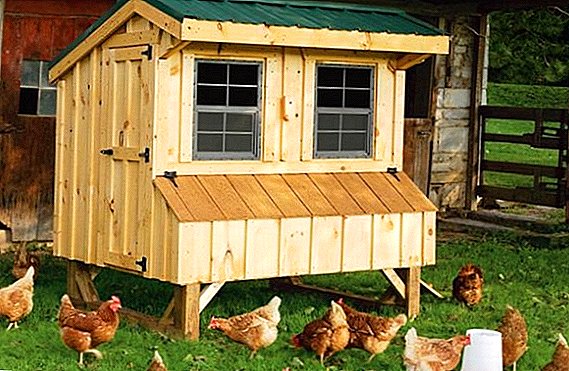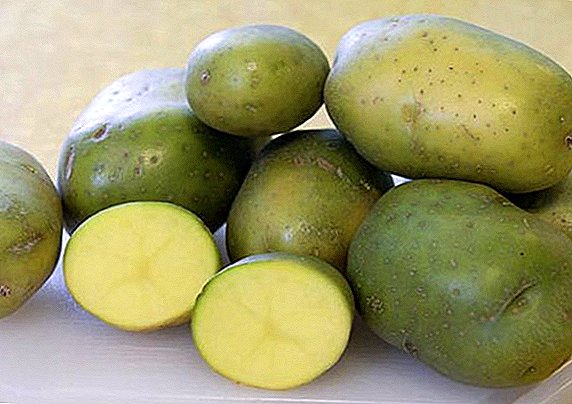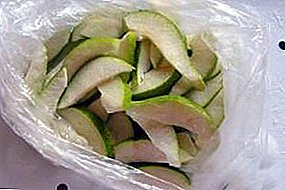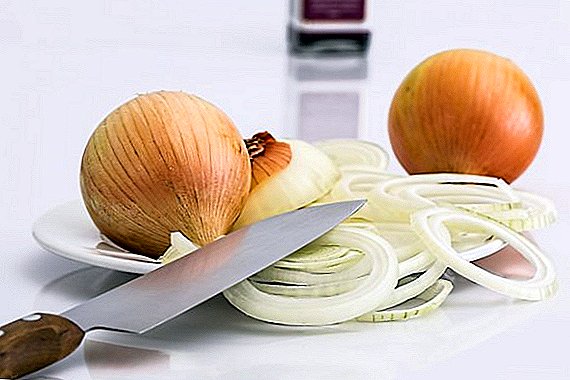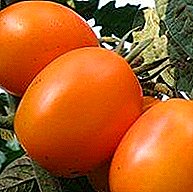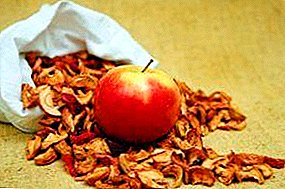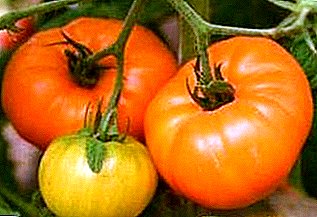
Altai tomato variety is a good choice for lovers of diversity. In the garden you can plant as many as three variants of these tomatoes - red, pink or orange.
High-yielding, with excellent taste and aroma, they will become a real decoration of your garden and table.
And in our article you will find a detailed description of the variety, you will get acquainted with its characteristics, learn everything about the features of cultivation, inclinations to diseases and damage by pests.
Altai tomatoes: variety description
| Grade name | Altaic |
| general description | Late-season, indeterminate, large-fruited variety for greenhouses. |
| Originator | Russia |
| Ripening | 110-115 days |
| The form | Fruits are flat-rounded, large, medium density. |
| Colour | The color of the ripe fruit is red, pink or orange depending on the variety. |
| Average tomato mass | 250-350 grams |
| Application | Good fresh, suitable for juices and sauces. |
| Yield varieties | 4 kg from a bush |
| Features of growing | Scheme - 50-40 cm. 3-4 plants per 1 sq. M. |
| Disease resistance | Sufficiently resistant to major diseases of the nightshade. Rarely affected by fuzarose, verticillus, tobacco mosaic |
 Altai is a high-yielding late-ripe hybrid. From the emergence of seedlings to maturation, 110-115 days pass. The bush is indeterminate, tall, moderately leafy. The height of an adult plant is about 150 cm. The leaves are large, simple, dark green. Inflorescences are simple. The fruits ripen with brushes of 4-6 pieces.
Altai is a high-yielding late-ripe hybrid. From the emergence of seedlings to maturation, 110-115 days pass. The bush is indeterminate, tall, moderately leafy. The height of an adult plant is about 150 cm. The leaves are large, simple, dark green. Inflorescences are simple. The fruits ripen with brushes of 4-6 pieces.
The fruiting period is extended, tomatoes can be collected from mid-summer until frost. Fruits of medium size, weighing from 250 to 300 g. The mass of individual specimens reaches 500 g. The shape is flat-rounded, with slight ribbing at the stem. Tomatoes are fleshy, juicy, with tender pulp melting in the mouth.
You can compare the weight of tomatoes of this variety with others in the table below:
| Grade name | Fruit weight (grams) |
| Altaic | 250-500 |
| Russian size | 650-2000 |
| Andromeda | 70-300 |
| Grandma's Gift | 180-220 |
| Gulliver | 200-800 |
| American ribbed | 300-600 |
| Nastya | 150-200 |
| Yusupovskiy | 500-600 |
| Dubrava | 60-105 |
| Grapefruit | 600-1000 |
| Golden anniversary | 150-200 |
The number of seed chambers is from 3 to 6. The skin is thin, but dense, well protecting the fruit from cracking.
The color of ripe tomatoes depends on the variety. Altai red tomato has fruits of a warm red shade. The skin is shiny, thin. The taste is bright, rich and sweet, with a barely noticeable sourness. Fruits are rich in lycopene, amino acids and beta carotene. The high content of sugars and dry substances allows us to recommend fruits for baby and diet food.
- Altai pink tomatoes are painted in warm pink color, the flesh has the same shade. Excellent taste, fruits are sweet, juicy, not watery.
- Pink tomatoes are very tender, they are suitable for people who are allergic to traditional red tomatoes. Altai orange tomatoes are distinguished by the fruits of juicy orange-yellow color.
- Bright orange flesh is sweet, with subtle fruity notes. The variety is ideal for making juices and mashed potatoes.

Origin and Application
The variety of tomato Altai bred by Russian breeders. It is recommended for cultivation in an open ground and under a film, in glass and polycarbonate greenhouses. Harvested fruits are well stored, transportation is possible.
Tomatoes are used for amateur or industrial cultivation, they are great for sale. Green tomatoes ripen quickly at room temperature. Altai red, pink and orange tomatoes belong to the salad type. Fleshy, juicy fruits are tasty fresh, they are used to make sandwiches, sauces, soups, mashed potatoes.
Ripe tomatoes make a delicious sweet juice, which you can drink freshly squeezed or procure for the future. Three varieties of tomatoes can be made tasty and beautiful vegetable platter, tomatoes are salted and pickled. They are well combined with other vegetables: cucumbers, peppers, cauliflower.
Advantages and disadvantages
Among the main advantages of the variety:
- color variety of fruits;
- good yield;
- excellent taste of tomatoes;
- easy care;
- tolerance for the vagaries of weather;
- resistance to major diseases.
The features include the need to form and tie up a bush. The variety is sensitive to the nutritional value of the soil, with insufficient dressings, the yield decreases.
It is possible to compare the yield of Altai with other varieties in the table below:
| Grade name | Yield |
| Altaic | 4 kg from a bush |
| De barao giant | 20-22 kg from a bush |
| Polbyg | 4 kg per square meter |
| Sweet bunch | 2.5-3.2 kg per square meter |
| Red bunch | 10 kg from a bush |
| Summer resident | 4 kg from a bush |
| Fat jack | 5-6 kg from a bush |
| Pink Lady | 25 kg per square meter |
| Countryman | 18 kg from a bush |
| Batyana | 6 kg from a bush |
| Golden anniversary | 15-20 kg per square meter |
Features of growing
 Altai varieties are best grown in seedlings. Before sowing, the seeds are disinfected in a solution of potassium permanganate, washed with clean water and dried. After that, the seed can be treated with a growth stimulator, significantly increasing germination.
Altai varieties are best grown in seedlings. Before sowing, the seeds are disinfected in a solution of potassium permanganate, washed with clean water and dried. After that, the seed can be treated with a growth stimulator, significantly increasing germination.
The soil for seedlings is made up of a mixture of garden soil with humus or peat. It is possible to add a small portion of washed river sand, superphosphate and wood ash. Seeds are sown in containers or peat cups with a slight deepening, sprinkled with peat and sprayed with water. You can use mini-greenhouses.
The use of individual containers will avoid subsequent picks. Landings are covered with foil and placed in heat. For seed germination need a temperature not lower than 25 degrees. It is necessary to plant tomatoes on the beds that were occupied by legumes, cabbage, lettuce, carrots or other cruciferous ones.
It is undesirable to use soil in which eggplants, physalis or peppers were grown. If there is no other option (for example, when using a common greenhouse), it is recommended to replace the top soil layer by thoroughly mixing it with peat or humus. How to prepare greenhouse soil read here.
Before planting the soil loosened. Tomatoes are planted in the wells, located at a distance of 40 to 50 cm from each other. Inter-row widths of 70-80 cm are required. Superphosphate mixed with potassium salts, or wood ash (1 tablespoon per plant) is placed along the holes.
When transplanting next to each bush supports are installed: durable stakes or metal rods. It is possible to use rope lanes to which you need to tie stalks and branches with fruits. Tomatoes need to be watered as the topsoil dries with warm settled water. In between watering grounds, the soil is loosened so that it does not form a hard crust, making it difficult for oxygen to enter.
During the season 3-4 feedings are carried out with a full complex fertilizer or organic matter (diluted mullein or bird droppings). Root and outside root dressings are possible, for example, spraying superphosphate diluted in water.
Read also how to use as a fertilizer yeast, iodine, hydrogen peroxide, ammonia and why tomatoes need boric acid.
A very important point - the formation of bushes. Tomatoes lead to 1-2 stems, removing the stepchildren above the third brush. If the stem is too pulled, you can pinch the point of growth.
It is recommended to remove the lower leaves on the plants, this will improve air exchange and sunlight access to the fruit. Many gardeners pinch off small or deformed flowers on the hands, so that future fruits are larger.
 We offer you useful materials about high-yielding varieties of tomatoes and resistant to various diseases.
We offer you useful materials about high-yielding varieties of tomatoes and resistant to various diseases.You may also find articles about the difference between determinant and indeterminant varieties of tomatoes.
A photo
Look at the photo below - Altai pink, red, orange variety tomatoes:



Diseases and pests

Striped mosaic
To prevent fungal diseases, apical and root rot, you need to carefully loosen the soil, removing weeds. Mulching of soil with straw, peat or humus will also help. Planting is useful to spray phytosporin or other non-toxic bio-drug. Read about other disease control measures here.
In the open field, tomatoes are threatened by pests. During the flowering period of the plant, the spider mite, whitefly, thrips attack, and later the bear, Colorado beetles, naked slugs appear. Detect unwanted guests will help weekly inspection of landings.
For prophylactic purposes, spraying with a weak solution of potassium permanganate is recommended. Industrial insecticides help from spider mites, but they can only be used before fruiting. Later, toxic compounds are replaced by tried and tested folk remedies: decoction of celandine or onion peel.
Slugs, Medvedka, the larvae of the Colorado potato beetle are harvested by hand, and the plants are sprayed with an aqueous solution of ammonia. Stalks affected by aphids, washed with warm soapy water, preventing it from entering the soil.
Choosing Altai varieties of tomatoes, you can be sure of the high quality of the crop. With proper care, the plants bear fruit throughout the season, delighting with color and flavor variety. Seeds for subsequent planting can be harvested on their own, from ripe tomatoes.
Read also all about how to grow the best crop of tomatoes in the open field, how to delight yourself with tasty tomatoes all year round, and what is the secret to growing early varieties.
We also bring to your attention articles on tomato varieties with different ripening terms:
| Medium early | Middle late | Mid-season |
| New Transnistria | Abakansky pink | Hospitable |
| Pullet | French grapevine | Red pear |
| Sugar giant | Yellow banana | Chernomor |
| Torbay | Titanium | Benito F1 |
| Tretyakovsky | Slot f1 | Paul Robson |
| Black Crimea | Volgogradsky 5 95 | Raspberry elephant |
| Chio Chio San | Krasnobay f1 | Mashenka |



